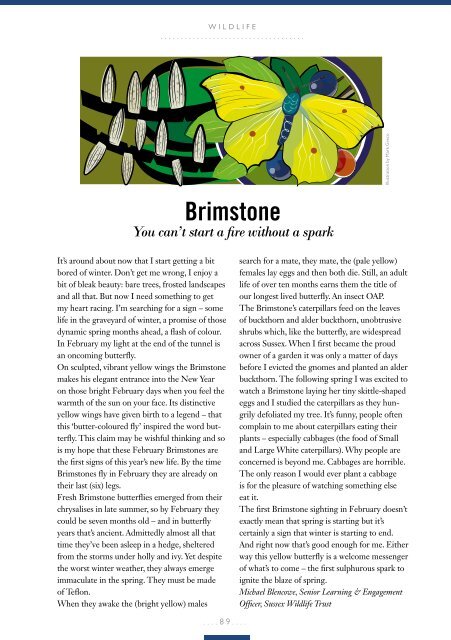Viva Brighton Issue #72 February 2019
You also want an ePaper? Increase the reach of your titles
YUMPU automatically turns print PDFs into web optimized ePapers that Google loves.
WILDLIFE<br />
....................................<br />
Illustration by Mark Greco<br />
Brimstone<br />
You can’t start a fire without a spark<br />
It’s around about now that I start getting a bit<br />
bored of winter. Don’t get me wrong, I enjoy a<br />
bit of bleak beauty: bare trees, frosted landscapes<br />
and all that. But now I need something to get<br />
my heart racing. I’m searching for a sign – some<br />
life in the graveyard of winter, a promise of those<br />
dynamic spring months ahead, a flash of colour.<br />
In <strong>February</strong> my light at the end of the tunnel is<br />
an oncoming butterfly.<br />
On sculpted, vibrant yellow wings the Brimstone<br />
makes his elegant entrance into the New Year<br />
on those bright <strong>February</strong> days when you feel the<br />
warmth of the sun on your face. Its distinctive<br />
yellow wings have given birth to a legend – that<br />
this ‘butter-coloured fly’ inspired the word butterfly.<br />
This claim may be wishful thinking and so<br />
is my hope that these <strong>February</strong> Brimstones are<br />
the first signs of this year’s new life. By the time<br />
Brimstones fly in <strong>February</strong> they are already on<br />
their last (six) legs.<br />
Fresh Brimstone butterflies emerged from their<br />
chrysalises in late summer, so by <strong>February</strong> they<br />
could be seven months old – and in butterfly<br />
years that’s ancient. Admittedly almost all that<br />
time they’ve been asleep in a hedge, sheltered<br />
from the storms under holly and ivy. Yet despite<br />
the worst winter weather, they always emerge<br />
immaculate in the spring. They must be made<br />
of Teflon.<br />
When they awake the (bright yellow) males<br />
search for a mate, they mate, the (pale yellow)<br />
females lay eggs and then both die. Still, an adult<br />
life of over ten months earns them the title of<br />
our longest lived butterfly. An insect OAP.<br />
The Brimstone’s caterpillars feed on the leaves<br />
of buckthorn and alder buckthorn, unobtrusive<br />
shrubs which, like the butterfly, are widespread<br />
across Sussex. When I first became the proud<br />
owner of a garden it was only a matter of days<br />
before I evicted the gnomes and planted an alder<br />
buckthorn. The following spring I was excited to<br />
watch a Brimstone laying her tiny skittle-shaped<br />
eggs and I studied the caterpillars as they hungrily<br />
defoliated my tree. It’s funny, people often<br />
complain to me about caterpillars eating their<br />
plants – especially cabbages (the food of Small<br />
and Large White caterpillars). Why people are<br />
concerned is beyond me. Cabbages are horrible.<br />
The only reason I would ever plant a cabbage<br />
is for the pleasure of watching something else<br />
eat it.<br />
The first Brimstone sighting in <strong>February</strong> doesn’t<br />
exactly mean that spring is starting but it’s<br />
certainly a sign that winter is starting to end.<br />
And right now that’s good enough for me. Either<br />
way this yellow butterfly is a welcome messenger<br />
of what’s to come – the first sulphurous spark to<br />
ignite the blaze of spring.<br />
Michael Blencowe, Senior Learning & Engagement<br />
Officer, Sussex Wildlife Trust<br />
....89....


















